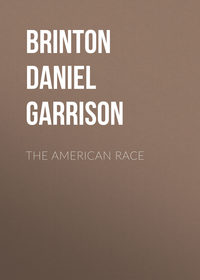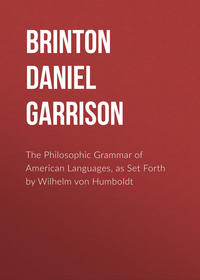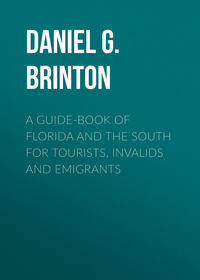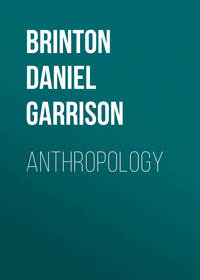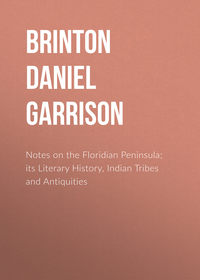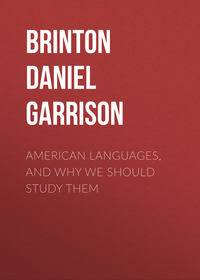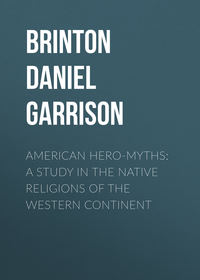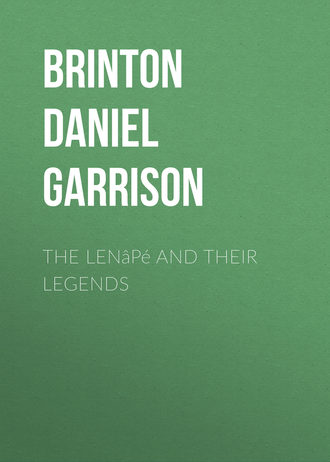 полная версия
полная версияThe Lenâpé and their Legends
The value of Indian corn, the Zea mais, must have been known to the Algonkin tribes while they still formed one nation, as the same name is applied to it by tribes geographically the widest apart. Thus the Micmacs of Nova Scotia call it pe-ãs'kumun-ul whose theme ãs'ku-mun reappears in the wuskannem (Elliott) and the scannemeneash (Roger Williams) of New England, in the Delaware jesquem (Campanius), and chasquem (Zeis.), and even in the Piegan Blackfoot esko-tope.
The first radical ask, Chip. ashk, Del. aski, means "green." The application is to the green waving plant, so conspicuous in the fields during the summer months. The second mün or min is a generic suffix applied to all sorts of small edible fruits. In the Blackfoot its place is supplied by another, and in the Unami Delaware it is abbreviated to the letter m.
On the other hand, in the Chipeway word for corn, mandamin, Ottawa mindamin, Cree mattamin, the second radical is retained in full, while for the first is substituted an abbreviation of manito, divine ("it is divine, supernatural, or mysterious"); if we may accept the opinion of Mr. Schoolcraft, and I know of no more plausible etymology.
Tobacco was called by the Delawares kscha-tey, Zeis., seka-ta, Camp., or in the English orthography shuate (Vocab. N. J. Inds.), and koshãhtahe (Cummmings). I am inclined to think that these are but dialectic variations and different orthographies of the root 'ta or 'dam (a nasal) found in the New England wuttãm-anog, Micmac tùmawa, Abnaki wh'dãman (Rasle), Cree tchistémaw, Chip. assema (= asté-maw), Blackfoot pi-stã-kan; a root which Dr. J. H. Trumbull has satisfactorily identified as meaning "to drink," the smoke being swallowed and likened to water. "To drink tobacco" was the usual old English expression for "to smoke."
If this etymology is correct, it leads to the inference that tobacco also was known to the ancient Algonkins before they split up into the many nations which we now know, and furthermore that they must have lived in a region where these two semi-tropical or wholly tropical plants, Indian corn and tobacco, had been already introduced and cultivated by some more ancient race. To conclude that they themselves brought them from a tropical land, would be too hazardous.
The pipes in which the tobacco was smoked were called appooke (modern Delaware o'pahokun', Cumings' Vocab.) They were of earthenware and of stone; sometimes, it is said, of copper. According to Kalm, the ceremonial pipes were of a red stone, possibly the western pipe stone, and were very highly prized.[84]
Of wild fruits and plants they consumed the esculent and nutritious tubers on the roots of the Wild Bean, Apios tuberosa, the large, oval, fleshy roots of the arrow-leaved Sagittaria, the former of which the Indians called hobbenis, and the latter katniss, names which they subsequently applied to the European turnip. They also roasted and ate the acrid cormus of the Indian turnip, Arum triphyllum, in Delaware taw-ho, taw-hin or tuck-ah, and collected for food the seeds of the Golden Club, Orontium aquaticum, common in the pools along the creeks and rivers. Its native name was taw-kee.[85]
House BuildingIn their domestic architecture they differed noticeably from the Iroquois and even the Mohegans. Their houses were not communal, but each family had its separate residence, a wattled hut, with rounded top, thatched with mats woven of the long leaves of the Indian corn or the stalks of the sweet flag (Acorus calamus,) or of the bark of trees (anacon, a mat, Z.) These were built in groups and surrounded with a palisade to protect the inhabitants from sudden inroads.[86]
In the centre was sometimes erected a mound of earth, both as a place of observation and as a location to place the children and women. The remains of these circular ramparts enclosing a central mound were seen by the early settlers at the Falls of the Delaware and up the Lehigh valley.
ManufacturesThe art of the potter was known and extensively practiced, but did not indicate any unusual proficiency, either in the process of manufacture or in the methods of decoration, although the late Mr. F. Peale thought that, in the latter respect, the Delaware pottery had some claims to a high rank.[87] The representation of animal forms was quite unusual, only some few and inferior examples having been found.
Their skill in manufacturing bead work and feather mantles, and in dressing deer skins, excited the admiration of the early voyagers. Although their weapons and utensils were mostly of stone, there was a considerable supply of native copper among them, in use as ornaments, for arrow heads and pipes. Some specimens of it have been found by Dr. Abbott near Trenton, and by other collectors in Pennsylvania,[88] and its scarcity in modern collections is to be attributed to its being bought up and melted by the whites rather than to its limited employment.
Soap stone was hollowed out with considerable skill, to form bowls, and the wood of the sassafras tree was highly esteemed for the same purpose (Kalm).
The maize was broken up in wooden or stone mortars with a stone pestle, the native name of which was pocohaac, a word signifying also the virile member.
Their arms were the war club or tomahawk, tomhickan, the bow, hattape, and arrow, alluns, the spear, tanganaoun, and for defence Bishop Ettwein states they carried a round shield of thick, dried hide.
The spear was also used for spearing fish, which they, moreover, knew how to catch with "brush nets," and with fish hooks made of bone and the dried claws of birds (Kalm).[89]
Paints and DyesThe paints and dyes used by the Lenape and neighboring Indians were derived both from the vegetable and mineral realms. From the former they obtained red, white and blue clays, which were in such extensive demand that the vicinity of those streams in New Castle county, Delaware, which are now called White Clay Creek and Red Clay Creek, was widely known to the natives as Walamink, the Place of Paint.
The vegetable world supplied a variety of dyes in the colored juices of plants. These were mixed with the acid juice of the wild, sweet-scented crab apple (Pyrus coronaria; in Lenape, tombic'anall), to fix the dye.
A red was yielded by the root of the Sanguinaria Canadensis, still called "Indian paint root;" an orange by the root of Phytolacca decandra, the poke or pocoon; a yellow by the root of Hydrastis Canadensis; a black by a mixture of sumac and white walnut bark, etc.[90]
DogsThe only domestic animal they possessed was a small species of dogs with pointed ears. These were called allum, and were preserved less for protection or for use in hunting than for food, and especially for ceremonial purposes.[91]
IntermentsThe custom of common ossuaries for each gens appears to have prevailed among the Lenape. Gabriel Thomas states that: "If a person of Note dies very far away from his place of residence, they will convey his Bones home some considerable Time after, to be buried there."[92] Bishop Ettwein speaks of mounds for common burial, though he appears to limit their use to times of war.[93]
One of these communal graveyards of the Minsis covers an area of six acres on the Neversink creek,[94] while, according to tradition, another of great antiquity and extent was located on the islands in the Delaware river, above the Water-Gap.[95]
Computation of TimeThe accuracy with which the natives computed time becomes a subject of prime consideration in a study of their annals. It would appear that the Eastern Algonkins were not deficient in astronomical knowledge. Roger Williams remarks, "they much observe the Starres, and their very children can give names to many of them;"[96] and the same testimony is borne by Wassenaer. The latter, speaking of the tribes around New York Harbor, in 1630, says that their year began with the first moon after the February moon; and that the time for planting was calculated by the rising of the constellation Taurus in a certain quarter. They named this constellation the horned head of some great fictitious animal.[97]
Zeisberger observes that, in his day, the Lenape did not have a fixed beginning to their year, but reckoned from one seeding time to another, or from when the corn was ripe, etc.[98] Nevertheless, they had a word for year, gachtin, and counted their ages and the sequence of events by yearly periods. The Chipeways count by winters (pipun-agak, in which the first word means winter, and the second is a plural form similar to the Del. gachtin); but the Lenape did not apparently follow them in this. They recognized only twelve moons in the year and not thirteen, as did the New England nations; at least, the names of but twelve months have been preserved.[99] The day periods were reckoned usually by nights, but it was not improper to count by "suns" or days.
Pictographic SignsThe picture writing of the Delawares has been quite fully described by Zeisberger, Loskiel and Heckewelder. It was scratched upon stone (Loskiel), or more frequently cut in or painted upon the bark of trees or pieces of wood. The colors were chiefly black and red. The system was highly conventionalized, so that it could readily be understood by all their tribes, and also by others with whom they came in contact, the Shawnees, Wyandots, Chipeways, etc.
The subjects had reference not merely to matters of present interest, but to the former history of their nation, and were directed "to the preservation of the memory of famous men, and to the recollection of events and actions of note." Therefore, their Agamemnons felt no anxiety for the absence of a Homer, but "confidently reckoned that their noble deeds would be held in memory long after their bodies had perished."[100]
The material on which the drawings were made was generally so perishable that few examples have been left to us. One, a stone about seven inches long, found in central New Jersey, has been described and figured by Dr. Abbott.[101] It represents an arrow crossing certain straight lines. Several "gorgets" (smooth stone tablets pierced with holes for suspension, and probably used for ceremonial purposes), stone knives and pebbles, showing inscribed marks and lines, and rude figures, are engraved in Dr. Abbott's book; others similar have been seen in Bucks and Berks counties, Pa.
There was a remarkable series of hieroglyphics, some eighty in number, on a rock at Safe Harbor, on the Susquehanna. They have been photographed and described by Prof. T. C. Porter, of Lancaster, but have yet to be carefully analyzed.[102] From its location, it was probably the work of the Susquehannocks, and did not belong to the general system of Algonkin pictography.
If the rude drawings appended to the early treatises as signatures of native sachems be taken as a guide, little or no uniformity prevailed in the personal signs. The same chieftain would, on various occasions, employ symbols differing so widely that they have no visible relation.[103]
An interesting incident is recorded by Friend John Richardson when on a visit to William Penn, at his manor of Pennsburg, in 1701. Penn asked the Indian interpreter to give him some idea of what the native notion of God was. The interpreter, at a loss for words, had recourse to picture writing, and describing a number of circles, one inside the other, he pointed to the centre of the innermost and smallest one, and there, "placed, as he said, by way of representation, the Great Man."[104] The explanation was striking and suggestive, and hints at the meaning of the not infrequent symbol of the concentric circles.
An alleged piece of Delaware pictography is copied by Schoolcraft[105] from the London Archæologia, Vol. IV. It purports to be an inscription found on the Muskingum river in 1780, and the interpretation is said to have been supplied by the celebrated Delaware chief, Captain White Eyes (Coquethagechton). As interpreted, it relates to massacres of the whites by the Delaware chief, Wingenund, in the border war of 1763.
There is a tissue of errors here. The pictograph, "drawn with charcoal and oil on a tree," must have been quite recent, and is not likely to have referred to events seventeen years antecedent. There is no evidence that Wingenund took part in Pontiac's conspiracy, and he was the consistent friend of the whites.[106] Several of the characters are not like Indian pictographs. And finally, White Eyes, the alleged interpreter in 1780, had died at Tuscarawas, two years before, Nov. 10th, 1778![107]
Record SticksThe Algonkin nations very generally preserved their myths, their chronicles, and the memory of events, speeches, etc., by means of marked sticks. As early as 1646, the Jesuit missionaries in Canada made use of these to teach their converts the prayers of the Church and their sermons.[108]
The name applied to these record or tally sticks was, among the Crees and Chipeways, massinahigan, which is the common word now for book, but which originally meant "a piece of wood marked with fire," from the verb masinákisan, I imprint a mark upon it with fire, I burn a mark upon it,[109] thus indicating the rude beginning of a system of mnemonic aids. The Lenape words for book, malackhickan, Camp., mamalekhican Zeis., were probably from the same root.
In later days, instead of burning the marks upon the sticks, they were painted, the colors as well as the figures having certain conventional meanings.[110]
These sticks are described as about six inches in length, slender, though varying in shape, and tied up in bundles.[111] Such bundles are mentioned by the interpreter Conrad Weiser, as in use in 1748 when he was on his embassy in the Indian country.[112] The expression, "we tied up in bundles," is translated by Mr. Heckewelder, olumapisid, and a head chief of the Lenape, usually called Olomipees, was thus named, apparently as preserver of such records.[113] I shall return on a later page to the precise meaning of this term.
The word signifying to paint was walamén, which does not appear in western dialects, but is found precisely the same in the Abnaki, where it is given by Rasles, 8ramann[114], which, transliterated into Delaware (where the l is substituted for the r), would be w'lam'an. From this word came Wallamünk, the name applied by the natives to a tract in New Castle county, Delaware, since at that locality they procured supplies of colored earth, which they employed in painting. It means "the place of paint."[115]
Roger Williams, describing the New England Indians, speaks of "Wunnam, their red painting, which they most delight in, and is both the Barke of the Fine, as also a red Earth."[116]
The word is derived from Narr. wunne, Del. wulit, Chip. gwanatsch = beautiful, handsome, good, pretty, etc.
The Indian who had artistically bedaubed his skin with red, ochreous clay, was esteemed In full dress, and delightful to look upon. Hence the term wulit, fine, pretty, came to be applied to the paint itself.
The custom of using such sticks, painted or notched, was by no means peculiar to the Delawares. They were familiar to the Iroquois, and the early travelers found them in common employment among the southern tribes.[117]
As the art advanced, in place of simple sticks, painted or notched, wooden tablets came into use, on which the symbols were scratched or engraved with a sharp flint or knife. Such are those still in use among the Chipeway, described by Dr. James as "rude pictures carved on a flat piece of wood;"[118] by the native Copway, as "board plates;"[119] and more precisely by Mr. Schoolcraft, as "a tabular piece of wood, covered on both sides with a series of devices cut between parallel lines."[120]
The Chipeway terms applied to these devices or symbols are, according to Mr. Schoolcraft, kekeewin, for those in ordinary and common use, and kekeenowin, for those connected with the mysteries, the "meda worship" and the "great medicine." Both words are evidently from a radical signifying a mark or sign, appearing in the words given in Baraga's "Otchipwe Dictionary," kikinawadjiton, I mark it, I put a certain mark on it, and kikinoamawa, I teach, instruct him.
Moral and Mental CharacterThe character of the Delawares was estimated very differently, even by those who had the best opportunities of judging. The missionaries are severe upon them. Brainerd described them as "unspeakably indolent and slothful. They have little or no ambition or resolution; not one in a thousand of them that has the spirit of a man."[121] No more favorable was the opinion of Zeisberger. He speaks of their alleged bravery with the utmost contempt, and morally he puts them down as "the most ordinary and the vilest of savages."[122]
Perhaps these worthy missionaries measured them by the standard of the Christian ideal, by which, alas, we all fall wofully short.
Certainly, other competent observers report much more cheerfully. One of the first explorers of the Delaware, Captain Thomas Young (1634), describes them as "very well proportioned, well featured, gentle, tractable and docile."[123]
Of their domestic affections, Mr. Heckewelder writes: "I do not believe that there are any people on earth who are more attached to their relatives and offspring than these Indians are."[124]
Their action toward the Society of Friends in Pennsylvania indicates a sense of honor and a respect for pledges which we might not expect. They had learned and well understood that the Friends were non-combatants, and as such they never forgot to spare them, even in the bloody scenes of border warfare.
"Amidst all the devastating incursions of the Indians in North America, it is a remarkable fact that no Friend who stood faithful to his principles in the disuse of all weapons of war, the cause of which was generally well understood by the Indians, ever suffered personal molestation from them."[125]
The fact that for more than forty years after the founding of Penn's colony there was not a single murder committed on a settler by an Indian, itself speaks volumes for their self-control and moral character. So far from seeking quarrels with the whites they extended them friendly aid and comfort.[126]
Even after they had become embittered and corrupted by the gross knavery of the whites (for example, the notorious "long walk,") and the debasing influence of alcohol, such an authority as Gen. Wm. H. Harrison could write these words about the Delawares: "A long and intimate knowledge of them, in peace and war, as enemies and friends, has left upon my mind the most favorable impression of their character for bravery, generosity and fidelity to their engagements."[127] More than this, and from a higher source, could scarcely be asked.
That intellectually they were by no means deficient is acknowledged by Brainerd himself. "The children," he writes, "learn with surprising readiness; their master tells me he never had an English school that learned, in general, so fast."[128]
Religious BeliefsWith the hints given us in various authors, it is not difficult to reconstruct the primitive religious notions of the Delawares. They resembled closely those of the other Algonkin nations, and were founded on those general mythical principles which, in my "Myths of the New World," I have shown existed widely throughout America. These are, the worship of Light, especially in its concrete manifestations of fire and the sun; of the Four Winds, as typical of the cardinal points, and as the rain bringers; and of the Totemic Animal.
As the embodiment of Light, some spoke of the sun as a deity,[129] while their fifth and greatest festival was held in honor of Fire, which they personified, and called the Grandfather of all Indian nations. They assigned to it twelve divine assistants, who were represented by so many actors in the ceremony, with evident reference to the twelve moons or months of the year, the fire being a type of the heavenly blaze, the sun.[130]
But both Sun and Fire were only material emblems of the mystery of Light. This was the "body or fountain of deity," which Brainerd said they described to him in terms that he could not clearly understand; something "all light;" a being "in whom the earth, and all things in it, may be seen;" a "great man, clothed with the day, yea, with the brightest day, a day of many years, yea, a day of everlasting continuance." From him proceeded, in him were, to him returned, all things and the souls of all things.
Such was the extraordinary doctrine which a converted priest of the native religion informed Brainerd was the teaching of the medicine men.[131]
The familiar Algonkin myth of the "Great Hare," which I have elsewhere shown to be distinctively a myth of Light,[132] was also well known to the Delawares, and they applied to this animal, also, the appellation of the "Grandfather of the Indians."[133] Like the fire, the hare was considered their ancestor, and in both instances the Light was meant, fire being its symbol, and the word for hare being identical with that of brightness and light.
As in Mexico and elsewhere, this light or bright ancestor was the culture hero of their mythology, their pristine instructor in the arts, and figured in some of their legends as a white man, who, in some remote time, visited them from the east, and brought them their civilization.[134]
I desire to lay especial stress on these proofs of Light worship among the Delawares, for it has an immediate bearing on several points in the Walam Olum. There are no compounds more frequent in that document than those with the root signifying "light," "brightness," etc., and this is one of the evidences of its authenticity.
Next in order, or rather, parallel with and a part of the worship of Light, was that of the Four Cardinal Points, always identified with the Four Winds, the bringers of rain and sunshine, the rulers of the weather.
"After the strictest inquiry respecting their notions of the Deity," says David Brainerd, "I find that in ancient times, before the coming of the white people, some supposed there were four invisible powers, who presided over the four corners of the earth."[135]
The Montauk Indians of Long Island, a branch of the Mohegans, also worshiped these four deities, as we are informed by the Rev Sampson Occum;[136] and Captain Argoll found them again in 1616 among the accolents of the Potomac, close relatives of the Delawares. Their chief told him: "We have five gods in all, our chief god appears often unto us in the form of a mighty great hare, the other four have no visible shape, but are indeed the four winds, which keep the four corners of the earth."[137]
These are the fundamental doctrines, the universal credo, of not only all the Algonkin faiths, but of all or nearly all primitive American religions.
This is very far from the popular conception of Indian religion, with its "Good Spirit" and "Bad Spirit." Such ideas were not familiar to the native mind. Heckewelder, Brainerd and Loskiel all assure us in positive terms that the notion of a bad spirit, a "Devil," was wholly unknown to the aborigines, and entirely borrowed from the whites. Nor was the Divinity of Light looked upon as a beneficent father, or anything of that kind. The Indian did not appeal to him for assistance, as to his totemic and personal gods.
These were conceived to be in the form of animals, and various acts of propitiation to them were performed. Such acts were not a worship of the animals themselves. Brainerd explains this very correctly when he says: "They do not suppose a divine power essential to or inhering in these creatures, but that some invisible beings, not distinguished from each other by certain names, but only notionally, communicate to these animals a great power, and so make these creatures the immediate authors of good to certain persons. Hence such a creature becomes sacred to the person to whom he is supposed to be the immediate author of good, and through him they must worship the invisible powers, though to others he is no more than another creature."[138]


